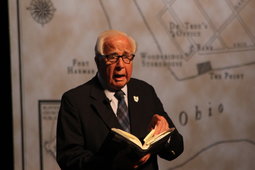
Photo courtesy of: Marietta College
David McCullough speaks at his book talk on May 31 at Peoples Bank Theatre in Marietta.
As songs from the Revolutionary War era rang throughout Peoples Bank Theatre in Marietta, Ohio, dozens of people readied themselves to be immersed in David McCullough’s new book by the author himself.
McCullough, a two-time Pulitzer Prize winning author, historian and recipient of the Presidential Medal of Freedom, recently released, “The Pioneers,” a heroic story of the settlers who brought the American Ideal West. Among those settlers was Manasseh Cutler, one of the founders of Ohio University.
To situate the audience in the proper time frame during, “An Evening with David McCullough,” on May 31, Marietta College Provost Janet Bland gave a unique twist to event housekeeping.
“We’re going to party like its 1788,” she said, to much laugher. “They didn’t have cellphones. Please take this moment to join our forefathers and turn off or silence your phone. We’re dependent on language now and meaningful books. Please note the exits, they are north, south, east and west in all four corners — in the unlikely event of a water landing, we will be exiting the building, so, like a pioneer, go to a new place.”
During the sold-out event, which was hosted by Marietta College, McCullough detailed how “The Pioneers” came to be. It was after being invited to Ohio University to serve as its undergraduate commencement speaker in 2004 that he learned of Cutler Hall and its designation as the oldest building erected for higher education west of the Alleghenies and north of the Ohio River.
So, McCullough did a little digging into the building’s namesake. That didn’t disappoint.
“I became entrenched with this man’s extraordinary life,” McCullough said at the event.
According to McCullough, Cutler was instrumental in opening the vast Northwest Territory to veterans of the Revolutionary War and their families for settlement. Cutler was a man of many talents. He attended school at Yale University (or Yale College back in the day), operated a store, practiced law and medicine, and was also a minister and a scientist-statesman.
“Manasseh Cutler was endowed with boundless intellectual curiosity,” writes McCullough in ‘The Pioneers.’ “It may be said he was a university unto himself, ranking high among the notable polymaths of the time, those ‘of great and varied excellence’ who took an interest in nearly everything.”
McCullough, also a Yale University graduate, starts off the book chronicling Cutler’s life and many accomplishments. Cutler was instrumental in the adoption of the Northwest Ordinance of 1787, which chartered a government for the Northwest Territory.
He believed that federal guarantees of support to religion and education were necessary for the settlement to succeed.
In the document, Cutler wrote, “Religion morality and knowledge being necessary to good government and the happiness of mankind schools and the means of education shall forever be encouraged.”
Those words are inscribed on Ohio University’s Class Gateway. OHIO was the first university chartered by an Act of Congress and the first to be chartered in Ohio; it was chartered in 1787 by the Congress of the Confederation, the governing body of the United States from March 1781 until March 1789.
McCullough writes that Ephraim Cutler, Manasseh Cutler’s son, and another settler named Rufus Putnam “took the lead at Chillicothe in the signing of a charter to establish a state university at the location first surveyed on a series of hills overlooking the Hocking River.”
The small college town would be called Athens, “and while it was Manasseh Cutler’s idea to name the new institution ‘American University,’ the name chosen was Ohio University,” McCullough writes.
“Ephraim’s active involvement with the creation of Ohio University had also become greater than ever,” he continues. “In 1816 work was proceeding on the first building on the campus, on the high ground of the College Green as it was called.”
The building was named Cutler Hall in 1914 in honor of the late Manasseh Cutler. The building now serves as a centerpiece on the Athens Campus and acts as a reminder of the University’s treasured past.